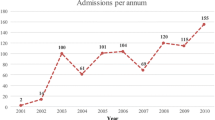Abstract
Purpose
This study aims to verify the impact that the length of stay has on the rates of readmission for patients who were first admitted to various inpatient psychiatric units in a large catchment area in a middle-income country.
Methods
The study included all patients who were first admitted to the 108 acute psychiatric beds available in the catchment area of Ribeirão Preto, Brazil, for a period of 8 years. Demographic features, inpatient unit of discharge, diagnosis and length of stay were assessed by bivariate analysis. An analysis of the time span between first admission and readmission was also conducted using survival curves estimated by the Kaplan–Meier formula. For the analyses of the risk of readmissions, a logistic regression analysis was conducted.
Results
From a total of 6261 patients admitted in the period of the survey, approximately one-third (2006) had at least one other readmission during the follow-up period. The rates per year of early readmission (within 90 days after discharge) varied from 16.1 to 20.9 %. The risk of readmission was higher immediately after discharge. The survival analysis showed that ultrashort length of stay (1–2 days) was associated with reduced odds of readmission, but multivariate logistic analysis showed no association between length of stay and the odds of readmissions. The predictors of early readmission included the diagnosis of depressive, bipolar, psychotic, and non-alcohol-related disorders, younger ages and unemployment.
Conclusions
Duration of the first psychiatric admission was not associated with a higher risk of readmissions. Predictors for early readmissions of first-time-admitted psychiatric patients seem to be more related to the severity of the psychiatric diagnosis and demographic characteristics.

Similar content being viewed by others
References
Thornicroft G, Tansella M (2013) The balanced care model: the case for both hospital- and community-based mental healthcare. Br J Psychiatry 202(4):246–248
Vicario M (2012) The, “crisis” crisis: emergency department use and community resources in North Carolina’s behavioral health crisis system. N C Med J 73(3):216–218
Silva NC, Bassani DG, Palazzo LS (2009) A case-control study of factors associated with multiple psychiatric readmissions. Psychiatr Serv 60(6):786–791
Sledge WH, Dunn CL, Schmutte T (2008) Surprising predictor of rehospitalization. Psychiatr Serv 59(5):577
Baruch Y, Kotler M, Lerner Y, Benatov J, Strous RD (2005) Psychiatric admissions and hospitalization in Israel: an epidemiologic study of where we stand today and where we are going. Isr Med Assoc J. 7(12):803–807
Priebe S, Katsakou C, Amos T, Leese M, Morriss R, Rose D et al (2009) Patients’ views and readmissions 1 year after involuntary hospitalisation. Br J Psychiatry 194(1):49–54
Saxena S, Lora A, Morris J, Berrino A, Esparza P, Barrett T et al (2011) Mental health services in 42 low- and middle-income countries: a WHO-AIMS cross-national analysis. Psychiatr Serv 62(2):123–125
Durbin J, Lin E, Layne C, Teed M (2007) Is readmission a valid indicator of the quality of inpatient psychiatric care? J Behav Health Serv Res. 34(2):137–150
Gastal FL, Andreoli SB, Quintana MI, Almeida Gameiro M, Leite SO, McGrath J (2000) Predicting the revolving door phenomenon among patients with schizophrenic, affective disorders and non-organic psychoses. Rev Saude Publica 34(3):280–285
Duncan JM, Short A, Lewis JS, Barrett PT (2002) Re-admissions to the State Hospital at Carstairs, 1992–1997. Health Bull Edinb 60(1):70–82
Zhou Y, Rosenheck RA, Mohamed S, Fan N, Ning Y, He H (2014) Retrospective assessment of factors associated with readmission in a large psychiatric hospital in Guangzhou, China. Shanghai Arch Psychiatry 26(3):138–148
Glick ID, Sharfstein SS, Schwartz HI (2011) Inpatient psychiatric care in the 21st century: the need for reform. Psychiatr Serv 62(2):206–209
Tulloch AD, David AS, Thornicroft G (2015) Exploring the predictors of early readmission to psychiatric hospital. Epidemiol Psychiatr Sci 1–13. doi:10.1017/S2045796015000128
Rash M (2012) North Carolina’s behavioral health delivery system: a historical perspective. N C Med J 73(3):185–188
Compton MT, Craw J, Rudisch BE (2006) Determinants of inpatient psychiatric length of stay in an urban county hospital. Psychiatr Q 77(2):173–188
Mark TL, Vandivort-Warren R, Owens PL, Buck JA, Levit KR, Coffey RM et al (2010) Psychiatric discharges in community hospitals with and without psychiatric units: how many and for whom? Psychiatr Serv 61(6):562–568
Slade EP, Goldman HH (2015) The dynamics of psychiatric bed use in general hospitals. Adm Policy Ment Health 42(2):139–146
Tulloch AD, Fearon P, David AS (2011) Length of stay of general psychiatric inpatients in the United States: systematic review. Adm Policy Ment Health 38(3):155–168
Mateus MD, Mari JJ, Delgado PG, Almeida-Filho N, Barrett T, Gerolin J et al (2008) The mental health system in Brazil: policies and future challenges. Int J Ment Health Syst 2(1):12
Mangalore R, Knapp M (2007) Cost of schizophrenia in England. J Ment Health Policy Econ 10(1):23–41
Paim J, Travassos C, Almeida C, Bahia L, Macinko J (2011) The Brazilian health system: history, advances, and challenges. Lancet 377(9779):1778–1797
Barros REM, Marques JMD, Carlotti IP, Zuardi AW, Del-Ben CM (2010) Short admission in an emergency psychiatry unit can prevent prolonged lengths of stay in a psychiatric institution. Rev Bras De Psiquiatr 32(2):145–151
DATASUS (2007) População Residente—São Paulo. População Residente segundo Município. Município: Ribeirão Preto. Período. Ministério da Saúde, Brasilia
IBGE. Instituto Brasileiro de Geografia e Estatística (IBGE) Cidades (2010) http://www.ibge.gov.br/cidadesat. Accessed 20 Mar 2010
Del-Ben CM, Marques JM, Sponholz A Jr, Zuardi AW (1999) Mental health policies and changes in emergency service demand. Rev Saude Publ 33(5):470–476
Rufino AC, Uchida RR, Vilela JA, Marques JM, Zuardi AW, Del-Ben CM (2005) Stability of the diagnosis of first-episode psychosis made in an emergency setting. Gen Hosp Psychiatry 27(3):189–193
Mantovani C, Labate CM, Sponholz A, deAzevedo Marques JM, Guapo VG, de Simone Brito dos Santos ME et al (2013) Are low doses of antipsychotics effective in the management of psychomotor agitation? A randomized, rated-blind trial of 4 intramuscular interventions. J Clin Psychopharmacol 33(3):306–312
StataCorp (2009) Stata Statistical Software: Release 11. StataCorp LP, College Station
AbuMadini MS, Rahim SI (2002) Psychiatric admission in a general hospital. Patients profile and patterns of service utilization over a decade. Saudi Med J 23(1):44–50
Lindsey MA, Joe S, Muroff J, Ford BE (2010) Social and clinical factors associated with psychiatric emergency service use and civil commitment among African–American youth. Gen Hosp Psychiatry 32(3):300–309
de Azevedo-Marques JM, Zuardi AW (2011) COOP/WONCA charts as a screen for mental disorders in primary care. Ann Fam Med 9(4):359–365
Thornicroft G, Tansella M (2004) Components of a modern mental health service: a pragmatic balance of community and hospital care: overview of systematic evidence. Br J Psychiatry 185:283–290
Slade M, Taber D, Clarke MM, Johnson C, Kapoor D, Leikin JB et al (2007) Best practices for the treatment of patients with mental and substance use illnesses in the emergency department. Dis Mon 53(11–12):536–580
Kolbasovsky A, Futterman R (2007) Predicting psychiatric emergency room recidivism. Manag Care Interface 20(4):33–38
Thornicroft G, Gooch C, Dayson D (1992) The TAPS project. 17: readmission to hospital for long term psychiatric patients after discharge to the community. BMJ 305(6860):996–998
Roick C, Heider D, Kilian R, Matschinger H, Toumi M, Angermeyer MC (2004) Factors contributing to frequent use of psychiatric inpatient services by schizophrenia patients. Soc Psychiatry Psychiatr Epidemiol 39(9):744–751
Callaly T, Hyland M, Trauer T, Dodd S, Berk M (2010) Readmission to an acute psychiatric unit within 28 days of discharge: identifying those at risk. Aust Health Rev 34(3):282–285
Craig TJ, Fennig S, Tanenberg-Karant M, Bromet EJ (2000) Rapid versus delayed readmission in first-admission psychosis: quality indicators for managed care? Ann Clin Psychiatry 12(4):233–238
Swett C (1995) Symptom severity and number of previous psychiatric admissions as predictors of readmission. Psychiatr Serv 46(5):482–485
Peen J, Dekker J (2003) Urbanisation as a risk indicator for psychiatric admission. Soc Psychiatry Psychiatr Epidemiol 38(9):535–538
Schmutte T, Dunn CL, Sledge WH (2010) Predicting time to readmission in patients with recent histories of recurrent psychiatric hospitalization: a matched-control survival analysis. J Nerv Ment Dis 198(12):860–863
Bobier C, Warwick M (2005) Factors associated with readmission to adolescent psychiatric care. Aust N Z J Psychiatry 39(7):600–606
Oliveira AM, Menezes PR, Busatto GF, McGuire PK, Murray RM, Scazufca M (2010) Family context and duration of untreated psychosis (DUP): results from the Sao Paulo Study. Schizophr Res 119(1–3):124–130
Zhou Y, Ning Y, Fan N, Mohamed S, Rosenheck RA, He H (2014) Correlates of readmission risk and readmission days in a large psychiatric hospital in Guangzhou, China. Asia Pac Psychiatry 6(3):342–349
Figueroa R, Harman J, Engberg J (2004) Use of claims data to examine the impact of length of inpatient psychiatric stay on readmission rate. Psychiatr Serv 55(5):560–565
Kropp S, Andreis C, te Wildt B, Reulbach U, Ohlmeier M, Auffarth I et al (2005) Psychiatric patients turnaround times in the emergency department. Clin Pract Epidemiol Ment Health 1:27
Rugkåsa J, Dawson J (2013) Community treatment orders: current evidence and the implications. Br J Psychiatry 203(6):406–408
Lien L (2002) Are readmission rates influenced by how psychiatric services are organized? Nord J Psychiatry 56(1):23–28
Acknowledgments
JLFS, AWZ and CMD-B are supported by a research fellowship from the “Conselho Nacional de Desenvolvimento Científico e Tecnológico” (CNPq). The authors are grateful to Jair J Mari and Magdalena Rzewuska for their comments and suggestions on the manuscript.
Author information
Authors and Affiliations
Corresponding author
Electronic supplementary material
Below is the link to the electronic supplementary material.
Rights and permissions
About this article
Cite this article
Barros, R.E.M., de Azevedo Marques, J.M., Santos, J.L.F. et al. Impact of length of stay for first psychiatric admissions on the ratio of readmissions in subsequent years in a large Brazilian catchment area. Soc Psychiatry Psychiatr Epidemiol 51, 575–587 (2016). https://doi.org/10.1007/s00127-016-1175-x
Received:
Accepted:
Published:
Issue Date:
DOI: https://doi.org/10.1007/s00127-016-1175-x




